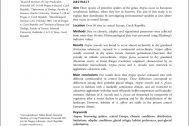Year
2007Authors
RNDr. Milan Řezáč, Ph.D.prof. Mgr. Stanislav Pekár, Ph.D.
Species
Atypus affinis Eichwald, 1830 LCAtypus muralis Bertkau, 1890 EN
Atypus piceus (Sulzer, 1776) VU
Content
Aim Three species of primitive spiders of the genus Atypus occur in European xerothermic habitats, where they live in burrows. The aim of this study is to explain their distribution by investigating environmental variables at sites where they occur in central Europe.
Location Over 50 sites in central Europe, Czech Republic.
Methods Data on climatic, edaphic and vegetational parameters were collected from more than 50 sites. Phytocenological data were processed using Ellenberg’s indicator values.
Results Atypus muralis was found to occur almost exclusively in dry grassland (Festucion valesiacae), exposed to a continental microclimate. Atypus affinis usually occurred in dry sparse forests (Genisto germanicae–Quercion) that provide an Atlantic microclimate. Atypus piceus occurred in dry grassland (Bromion erecti) or forest fringes (Geranion sanguinei) characterized by an intermediate microclimate. Atypus piceus and Atypus muralis were restricted to agglutinate calcareous soils.
Main conclusions Our results show that Atypus species colonized sites with different continentality in central Europe. These differences correspond to differences among their probable glacial refugia. Atypus muralis and Atypus piceus occur in habitats with a markedly continental climate, and are restricted to calcareous agglutinate soils that more efficiently buffer temperature and humidity extremes. Habitats of Atypus muralis and Atypus piceus are threatened by overgrowth of vegetation after a recent decline in grazing and by the decalcification of the landscape. However, habitats of Atypus affinis are stable in the present central European climate.



